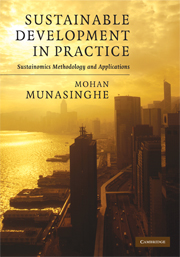Book contents
- Frontmatter
- Contents
- Foreword by James Gustave Speth
- Preface
- Part I Framework and fundamentals
- Part II Global and transnational applications
- Part III National and macroeconomic applications
- 7 National economy-wide applications
- 8 Mathematical macromodel applications
- 9 Computable general equilibrium modelling applications
- Part IV Sub-national sectoral and system applications
- Part V Project and local applications
- References
- Index
7 - National economy-wide applications
Published online by Cambridge University Press: 05 August 2012
- Frontmatter
- Contents
- Foreword by James Gustave Speth
- Preface
- Part I Framework and fundamentals
- Part II Global and transnational applications
- Part III National and macroeconomic applications
- 7 National economy-wide applications
- 8 Mathematical macromodel applications
- 9 Computable general equilibrium modelling applications
- Part IV Sub-national sectoral and system applications
- Part V Project and local applications
- References
- Index
Summary
In this chapter, the sustainomics framework is used to study the powerful and widespread social and environmental impacts of economy-wide policies (see Section 3.7). Section 7.1 contains a brief review of the historical evolution of ideas linking economy-wide policies and the environment – starting with the seminal work of Malthus and Ricardo up to modern times. Economy-wide policies (both macroeconomic and sectoral) are often packaged within programmes of structural adjustment, stabilization and sectoral reform, aimed at promoting economic stability, efficiency and growth, and ultimately improving human welfare. Section 7.2 describes empirical evidence, beginning with a discussion of the environmental impacts of structural adjustment programmes since the 1980s, followed by some stylized results. It is the combination of growth and economic imperfections that lead to environmental damage and unsustainable outcomes. Section 7.3 sets out a basic framework for analysing environmental–macroeconomic links. Unforeseen economic imperfections can interact with growth to cause environmental and social harm. Second-best remedial measures could help to limit the damage. In some cases, the timing and sequencing of macroeconomic reform policies could be adjusted to limit environmental and social harm. The standard static IS-LM macroeconomic model may be extended to include environmental concerns. The role of green accounting is discussed. The Action Impact Matrix (AIM) is a key tool for prioritizing environmental–macroeconomic links. A ‘policy-tunnelling’ model shows how complementary policies that eliminate economic imperfections will permit continued growth while limiting environmental and social harm.
- Type
- Chapter
- Information
- Sustainable Development in PracticeSustainomics Methodology and Applications, pp. 211 - 242Publisher: Cambridge University PressPrint publication year: 2009



